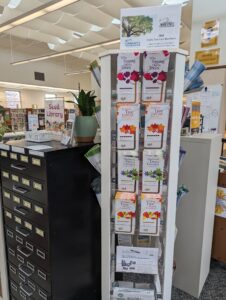
Stephanie Morrissette
Stephanie Morrissette is an avid naturalist and a Library Assistant in the Adult Services Department at CDPL.
 Happy Arbor Day Crawfordsville! Did you know that trees provide more than aesthetic and environmental beautification? Trees improve our air quality, providing us with life-giving oxygen, providing wildlife habitat, mitigating air pollution, and reducing ground and air temperatures. They reduce noise, create a traffic flow along streets and roads, improve feelings of relaxation, provide recreational opportunities, and increase tourism. The post-life value of trees includes wood products, lumber, pellets, mulch, and toilet paper. Did you know that trees can increase your property value, and provide energy-reducing strategies through windbreaks to conserve heat, and shade trees can reduce AC costs? Trees improve a community’s stormwater retention through their roots slowing down rainwater runoff to reduce flooding and provide almost $79 million in economic benefits to cities and towns (IDNR 2023).
Happy Arbor Day Crawfordsville! Did you know that trees provide more than aesthetic and environmental beautification? Trees improve our air quality, providing us with life-giving oxygen, providing wildlife habitat, mitigating air pollution, and reducing ground and air temperatures. They reduce noise, create a traffic flow along streets and roads, improve feelings of relaxation, provide recreational opportunities, and increase tourism. The post-life value of trees includes wood products, lumber, pellets, mulch, and toilet paper. Did you know that trees can increase your property value, and provide energy-reducing strategies through windbreaks to conserve heat, and shade trees can reduce AC costs? Trees improve a community’s stormwater retention through their roots slowing down rainwater runoff to reduce flooding and provide almost $79 million in economic benefits to cities and towns (IDNR 2023).
In addition to all those benefits, planting a tree in the right location is of utmost importance. Selecting the right tree for the right place can ensure the success and life of your tree. It is essential to consider the height of the tree at maturity to fit your designated space, soil requirements, water requirements, and maintenance issues. In addition, proper planting techniques are necessary. Trees should be planted no deeper than the root flare (wider flare at the base of the trunk), the hole should be two times wider than the rootball, and the rope or wire basket should be removed before planting. Then, give it a good watering. You can learn more about best practices with Dwight McCurdy in “How to Choose Your Tree: A Guide to Parklike Landscaping in Illinois, Indiana, and Ohio” (715.2 McC), and “Native Trees, Shrubs, and Vines for Urban and Rural America: A Planting Design Manual for Environmental Designers” by Gary Hightshoe (715.0973 Hig).
Trees are a part of the community, and the term used to describe the tree canopy in cities is called community forestry, or urban forestry. Some cities throughout Indiana and across the nation have specific plans in place for caring for city trees. Many cities have tree ordinances that provide guidelines for planting trees in city right-of-way and public parks, and a tree board that makes decisions regarding the proper care and maintenance of trees. Sometimes, there is a city forester to manage the community forest. A trained professional or a contracted arboreal company can prepare a street tree inventory. Arboreal companies develop and maintain precise information on tree species, age, size, and location that can be mapped on a detailed spatial database (ArcGIS Tree Data Management). Cities that meet the criteria for a program called Tree City USA can receive signage and recognition through the Arbor Day Foundation. Would you like to learn about your state’s rules on fences, trees, and other greenery that crosses the property line? Check out Nolo’s Guide to Neighbor Law: Fences, Trees, Boundaries & Noise by Emily Doskow (346.7304 Dos).
At CDPL, we have a wide selection of books and media on the benefits of trees for our physical and mental health and our overall sense of well-being. “The Hidden Life of Trees: What They Feel, How They Communicate: Discoveries from a Secret World” (582.16 Who) and “Forest Walking” (582.16097 Who) by Peter Wohlleben will provide you with a different perspective on experiencing the world when surrounded by those monumental, graceful beings. Our collection has various materials to assist you in identifying trees as well. Some favorites include “An Instant Guide to Trees: Nearly 200 of the Most Common North American Trees Described and Illustrated in Full Color” by Eleanor Lawrence (582.16 Law), “Trees of Indiana: Field Guide” by Stan Tekiela (582.16 Tek) and “Native Trees of the Midwest: Identification, Wildlife Values, and Landscaping Use” by Sally Weeks (582.16 Wee).
We also have, in partnership with Crawfordsville Main Street, a new Arbor Day kiosk full of tree-care brochures that is located right next to our Seed Library on the library’s second floor. The brochures are made available by a Montgomery County Community Foundation grant. Come help yourself to some free informational brochures.
The library is open from 9 am to 9 pm Monday through Thursday, Friday and Saturday from 9 am to 5 pm and Sunday from 1 pm to 5 pm.
